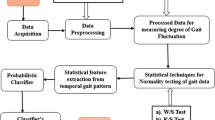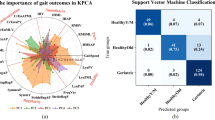Abstract
This work presents the evaluation of gait spatio-temporal and statistical parameters for automatic classification of human gait. A bundle of clinically relevant walk features is obtained from a cohort of healthy controls as well as neuro-impaired subjects and is normalized using dimensionless normalization to account for physiological variation like height, weight, etc. For feature selection and optimization, significant differences between the derived features from both groups are computed. A machine learning strategy is employed to train and classify these data into healthy and pathological group. The classifier reported a best classification accuracy of around 96% with both dimensional and dimensionless feature sets, with absolute minimum accuracy of just over 90%. The present work demonstrates the effectiveness of spatio-temporal and derived statistical features for gait classification. Extraction of such features is a relatively low-cost and less burdensome process in comparison with traditional approaches involving raw kinetic or kinematic parameters such as ground reaction force and bio-signals.
Access this chapter
Tax calculation will be finalised at checkout
Purchases are for personal use only
Similar content being viewed by others
References
Ferber, R., et al.: Gait biomechanics in the era of data science. J. Biomech. 49(16), 3759–3761 (2016)
Qin, L.-y., Ma, H., Liao, W.-H.: Insole plantar pressure systems in the gait analysis of post-stroke rehabilitation. In: 2015 IEEE International Conference on Information and Automation. IEEE (2015)
Tahir, A.M., et al.: A systematic approach to the design and characterization of a smart insole for detecting vertical ground reaction force (vGRF) in gait analysis. Sensors 20(4), 957 (2020)
Liu, T., Inoue, Y., Shibata, K.: A wearable ground reaction force sensor system and its application to the measurement of extrinsic gait variability. Sensors 10(11), 10240–10255 (2010)
Caldas, R., et al.: A systematic review of gait analysis methods based on inertial sensors and adaptive algorithms. Gait Posture 57, 204–210 (2017)
Muro-De-La-Herran, A., Garcia-Zapirain, B., Mendez-Zorrilla, A.: Gait analysis methods: an overview of wearable and non-wearable systems, highlighting clinical applications. Sensors 14(2), 3362–3394 (2014)
Tao, W., et al.: Gait analysis using wearable sensors. Sensors 12(2), 2255–2283 (2012)
Singh, J., Singh, P., Malik, V.: Effect of intrinsic parameters on dynamics of STN model in parkinson disease: a sensitivity-based study. In: Soft Computing: Theories and Applications, pp. 417–427. Springer, Berlin
Hsu, Y.-L., et al.: Gait and balance analysis for patients with Alzheimer’s disease using an inertial-sensor-based wearable instrument. IEEE J. Biomed. Health Inf. 18(6), 1822–1830 (2014)
Marquis, S., et al.: Independent predictors of cognitive decline in healthy elderly persons. Arch. Neurol. 59(4), 601–606 (2002)
Lakany, H.: Extracting a diagnostic gait signature. Pattern Recogn. 41(5), 1627–1637 (2008)
Thanasoontornrerk, R., et al.: Tree induction for diagnosis on movement disorders using gait data. In: 2013 5th International Conference on Knowledge and smart technology (KST). IEEE (2013)
Begg, R.K., Palaniswami, M., Owen, B.: Support vector machines for automated gait classification. IEEE Trans. Biomed. Eng. 52(5), 828–838 (2005)
Williams, G., et al.: Classification of gait disorders following traumatic brain injury. J. Head Trauma Rehabil. 30(2), E13–E23 (2015)
Mannini, A., et al.: A machine learning framework for gait classification using inertial sensors: application to elderly, post-stroke and Huntington’s disease patients. Sensors 16(1), 134 (2016)
Begum, S.V., Rani, M.P.: Recognition of neurodegenerative diseases with gait patterns using double feature extraction methods. In: 2020 4th International Conference on Intelligent Computing and Control Systems (ICICCS). IEEE (2020)
Joyseeree, R., Abou Sabha, R., Müller, H.: Applying machine learning to gait analysis data for disease identification. Stud. Health Technol. Inf. 210, 850–854 (2015)
Tahir, N.M., Manap, H.H.: Parkinson disease gait classification based on machine learning approach. J. Appl. Sci. (Faisalabad) 12(2), 180–185 (2012)
Das, R., Hooda, N., Kumar, N.: A Novel Approach for real-time gait events detection using developed wireless foot sensor module. IEEE Sens. Lett. 3(6), 1–4 (2019)
Hooda, N., Das, R., Kumar, N.: Fusion of EEG and EMG signals for classification of unilateral foot movements. Biomed. Signal Process. Control 60, 101990 (2020)
Teufl, W., et al.: Towards inertial sensor based mobile gait analysis: Event-detection and spatio-temporal parameters. Sensors 19(1), 38 (2019)
Iosa, M., et al., The golden ratio of gait harmony: repetitive proportions of repetitive gait phases. BioMed Res. Int. 2013 (2013)
Błażkiewicz, M., Wiszomirska, I., Wit, A.: Comparison of four methods of calculating the symmetry of spatial-temporal parameters of gait. Acta Bioeng. Biomech. 16(1) (2014)
Goldberger, A.L., et al.: Fractal dynamics in physiology: alterations with disease and aging. Proc. Natl. Acad. Sci. 99(suppl 1), 2466–2472 (2002)
Hof, A.L.: Scaling gait data to body size. Gait Posture 3(4), 222–223 (1996)
Kamruzzaman, J., Begg, R.K.: Support vector machines and other pattern recognition approaches to the diagnosis of cerebral palsy gait. IEEE Trans. Biomed. Eng. 53(12), 2479–2490 (2006)
Wahid, F., et al.: Classification of Parkinson’s disease gait using spatial-temporal gait features. IEEE J. Biomed. Health Inf. 19(6), 1794–1802 (2015)
Beauchet, O., et al.: Guidelines for assessment of gait and reference values for spatiotemporal gait parameters in older adults: the biomathics and Canadian gait consortiums initiative. Front. Hum. Neurosci. 11, 353 (2017)
Author information
Authors and Affiliations
Editor information
Editors and Affiliations
Rights and permissions
Copyright information
© 2022 The Author(s), under exclusive license to Springer Nature Singapore Pte Ltd.
About this paper
Cite this paper
Das, R., Khera, P., Saxena, S., Kumar, N. (2022). Automated Gait Classification Using Spatio-Temporal and Statistical Gait Features. In: Sharma, T.K., Ahn, C.W., Verma, O.P., Panigrahi, B.K. (eds) Soft Computing: Theories and Applications. Advances in Intelligent Systems and Computing, vol 1380. Springer, Singapore. https://doi.org/10.1007/978-981-16-1740-9_40
Download citation
DOI: https://doi.org/10.1007/978-981-16-1740-9_40
Published:
Publisher Name: Springer, Singapore
Print ISBN: 978-981-16-1739-3
Online ISBN: 978-981-16-1740-9
eBook Packages: Intelligent Technologies and RoboticsIntelligent Technologies and Robotics (R0)




